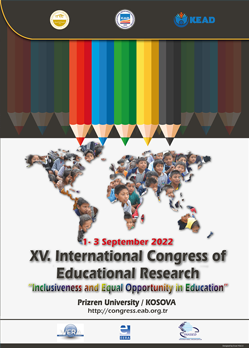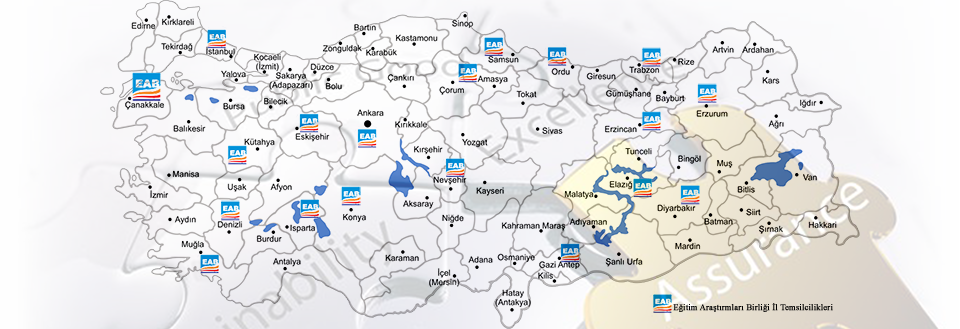
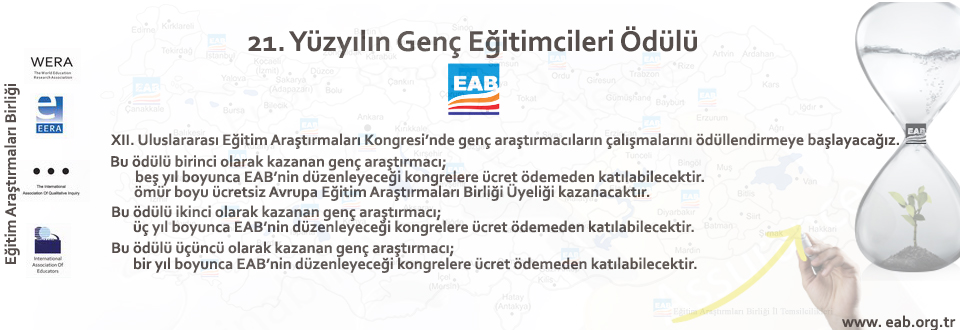

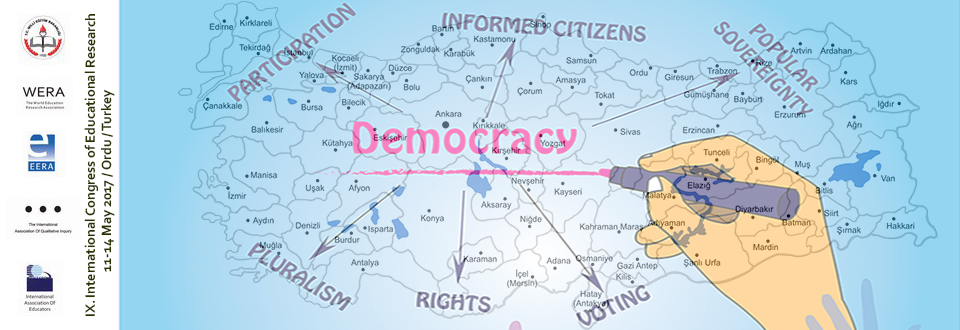
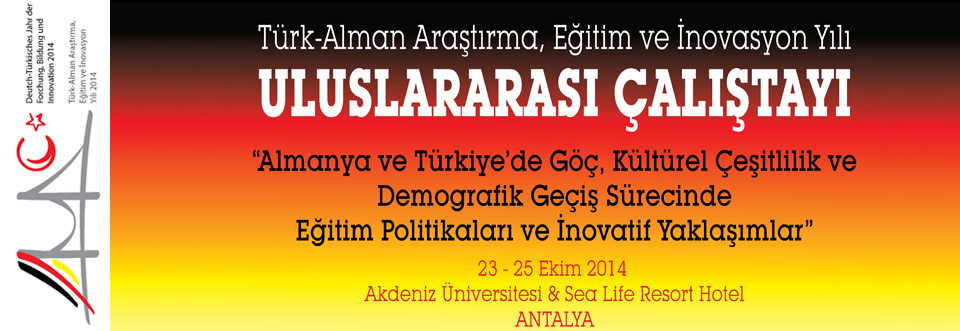
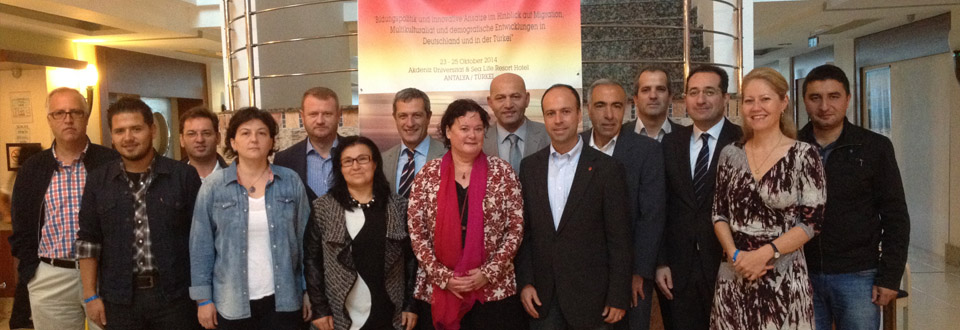
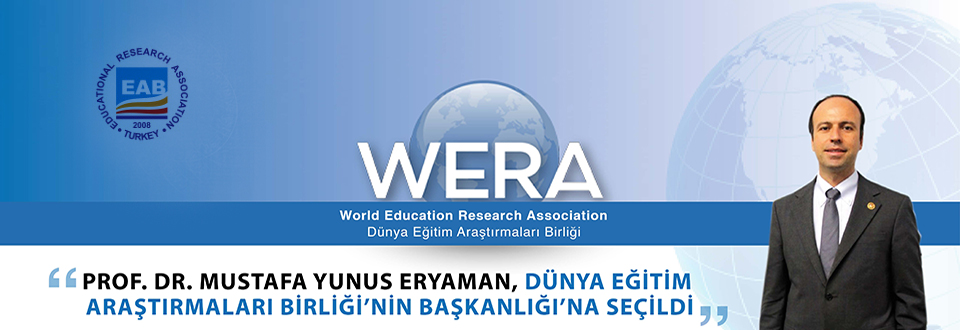
















| Name and Center of Association Article 1: Name of Association: “EDUCATIONAL RESEARCH ASSOCIATION” (ERA) Center of Association: “ÇANAKKALE” - No branches will be opened Aims of Association and Fields of Study Article 2: The Association aims at carrying out national and international educational research, and arranging scientific meetings such as workshops, panels, seminars, symposiums, conferences, etc. in the field of education. Furthermore, ERA aims to determine the standard of educational research in the following fifteen disciplines which are offered as undergraduate programs at faculties of education: 1. Educational Administration 2. Educational Policies 3. Educational Programs and Instruction 4. Educational Technologies 5. Science Education 6. Elementary Education 7. Fine Arts Education 8. Early Childhood Education 9. Special Education 10. Teacher Training 11. Psychological Counseling and Guidance 12. Social Studies Education 13. Physical Training and Sports Education 14. Technical and Vocational Education 15. Foreign Language Education. Another aim of The Educational Research Association is to index the journals published in Turkey on educational research and constitute within its body an excellence center equipped with the technology, data bases, web sites and indexing programs which are essential to perform academic studies in the field of education. Determining ethical standards for educational research and implementing membership and cooperation with international associations are also among the Association’s aims. Activities to be Carried Out by the Association 1. Conducting research to develop and carry out various activities. 2. Arranging educational activities such as courses, seminars, conferences and panels. 3. Obtaining all necessary information, files, documents, and publications to realize the aim of constituting a documentation center; publishing a newspaper and/or magazine and books to inform the public about the studies carried out by the Association; and issuing bulletins to be distributed to the members of the Association. 4. Providing a healthy working environment equipped with the necessary technical devices and office supplies. 5. Implementing fund-raising activities by obtaining the required permit. Accepting donations from within Turkey and from abroad. 6. Collecting income through establishing and managing financial, commercial and industrial corporations for the purpose of raising the funds of the association to realize the aims stated in the constitution. 7. Opening clubs and establishing social and cultural facilities for members’ spare time activities and other benefits. 8. Organizing activities such as dinner parties, concerts, balls, plays, exhibitions, sports, and trips in order to develop and maintain good relations between, among members and ensure the benefit of members from these activities. 9. Purchasing and renting moveable and real estate properties in order to carry out the activities to be organized by the Association and constituting limited property rights on real properties. 10. If the necessity arises, establishing a foundation or a federation, joining an established federation, or building facilities by obtaining the required permits. 11. Carrying out international activities, becoming a member of foreign foundations and associations, and implementing joint studies such as projects with these foundations. 12. If the necessity arises for the realization of these aims, carrying out joint projects with public bodies and institutions without prejudice to the legislative provisions of law number 5072 which regulates relations between public institutions and associations and foundations. 13. Establishing funds in order to fund the needs of members with such items as food, clothes, and short-term credit. 14. Opening representative agencies in certain areas to carry out activities on behalf of the Association. 15. Establishing legal platforms with other associations, foundations, unions and non-governmental organizations in the fields that are related with the aims of the Association and that are not prohibited by law. Procedure for Membership and Membership Rights Article 3: Each real and legal person who has the legal capacity and who adopts the aims and principles of the ERA and bears the qualities that the legislation requires has the right to become a member of the Association. However, foreign citizens need to have the right of abode in Turkey in order to become a member. This condition is not pertinent in the case of honorary membership. Each written membership application to the Association is evaluated and decided upon by the Executive Committee with acceptance or refusal of the membership within thirty days and the applicant is informed in writing. Names of new members are added to the registry book. Founders of the Association and persons who are accepted for membership by the Executive Committee, upon their written application for membership, are associate members of the ERA. Persons who contribute to the Association through material and spiritual support can be accepted as honorary members upon the decision of the Executive Committee. Resignation from Membership Article 4: Each member has the right to resign from membership by submitting a written notice. The resignation process is considered to be complete when the resignation petition reaches the Executive Committee. Resignation from membership does not end the accrued debt of the member to the Association. Exclusion from Membership Article 5: Circumstances that may result in exclusion from membership: 1. Acting against the constitution of the Association. 2. Persistent avoidance of duties. 3. Not paying the membership fee despite written warnings. 4. Not obeying decisions made by the administrative organs of the Association. 5. Lack of membership requirements A person is excluded from membership when one or more of the conditions stated above occur. The person or persons excluded from membership are erased from the members’ registry book and they cannot claim the assets of Association. Organs of the Association Article 6: The organs of the Association are as stated below. 1. General Board 2. Executive Committee 3. Auditing Board 4. Advisory Board 5. Council of Educational Research Establishment Procedure for General Board of Association, Meeting Schedule, Meeting Calls, and Meeting Procedure Article 7: The General Board is the highest authorized decision-making organ of the Association and is formed of Association members. The General Board: 1. Meets regularly on the scheduled dates stated in the regulations. 2. Holds emergency meetings within 30 days when the Executive Committee or Auditing Board requires it, or when 1 out of 5 members of the Association submit a written request for a meeting. Regular meeting of the General Board, which is called the General Assembly,is held once every 3 years, in August. The exact venue, date and time are determined by the Executive Committee. A call for the General Assembly is made by the Executive Committee. If the Executive Committee does not call the General Board to meet, then the magistrate will assign three members to make this call upon application by any one of the General Board members. Call Procedure The Executive Committee prepares the list of members who have the right to attend the General Assembly in accordance with the Regulations of the Association. The members who have right to attend the General Assembly are called for the meeting either by announcing the date, venue, time and agenda of the meeting in a local newspaper or by informing members via mail or e-mail. If the meeting cannot be held because of failure to constitute a majority despite the call for the meeting, the date, time and venue of a second meeting is determined and stated. The time period between the first and second meeting cannot be less than seven days or more than sixty days. If the meeting is postponed for any reason other than failing to constitute a majority, this situation is announced to members via the same call means used for the first meeting, including the reasons for the postponement. The second meeting should be held within six months of the date of the postponement. The members are called for this second meeting in accordance with the principles stated in the first item. The General Assembly cannot be postponed more than once. Meeting Procedure The General Assembly starts on condition that an absolute majority of the members is constituted. In the situation where the constitution is to be changed or the Association to be dissolved, the General Assembly starts with the attendance of 2/3 of its members. If the meeting is postponed because of failure to constitute a majority, the majority is not necessary in the second meeting. However, the number of members attending this meeting cannot be less than twice the number of the Executive Committee and Auditing Board members. A list of members who have the right to attend the meeting should be available at the meeting venue. Officially issued identity cards of the members who will attend the meeting are checked by the members of the Executive Committee or officers assigned by the Executive Committee. Each member attends the meeting by signing next to their name on the list prepared by the Executive Committee. If the quorum for the meeting is met, this situation is verified through a protocol and the meeting is initiated by the Chair or one of the members of the Executive Committee assigned by the Chair. If the quorum for the meeting cannot be provided, an official document is prepared by the Executive Committee. The Council Committee is constituted after the opening through electing the Chair of the Council Committee to manage the meeting and a Vice Chair and Secretary. It is mandatory that the members, casting votes submit their identity cards to the Council Committee and sign the allocated place by their names in the participant list during the voting process carried out to elect the organs of the Association. The chair of the Council Committee is responsible for managing the meeting and providing security. The issues which are on the agenda are discussed during the General Assembly. Additionally, it is mandatory to discuss the issues which were proposed in writing by 1 out of 10 of the members who are present at the meeting. Each member has a right to vote once in the General Assembly; and the member should cast his/her vote personally. Honorary members may attend the General Assembly but they cannot vote. If a legal person becomes a member, a person who is assigned by the chair of the legal person’s Executive Committee or a representative who is assigned by the legal person votes on his/her behalf. The issues discussed and decisions made in the meeting are written in the proceedings and signed by the Chair of the Council Committee and the Secretary. The proceedings and other documents are submitted to the chair of the Executive Committee at the end of the meeting. The chair of the Executive Committee is responsible for preserving these documents and submitting them to the newly-elected Executive Committee within seven days. Form and Manner of Voting for General Board and Decision-Making Article 8 – Unless a decision to the contrary has been taken in the General Assembly, the election of members of the Executive Committee and Auditing Board is made by secret ballot voting, and other decisions are taken by open voting. Secret ballots, sealed by the Chair, are collected in an empty box and are counted openly after the voting procedure ends. In open voting, the method to be determined by the Chair will be followed. The decisions of the General Assembly are taken by an absolute majority. However, decisions concerning the changing of constitution or dissolving the Association can only be taken by two thirds of the members attending the meeting. Decisions Taken Without Invitation or Meeting Decisions taken without the participation of all members but with their written attendance, and decisions taken by all members of the Association without following the written invitation procedure, are valid. These means of decision-making do not however stand in place of an ordinary meeting. Duties and Authority of the General Board Article 9 – The mattersbelow are negotiated and concluded by the General Board members attending the General Assembly. 1 - Election of Association executives. 2 - Change in the constitution 3 - Negotiation of the reports of the Executive Committee and Auditing Board and discharge of the Executive Committee. 4 - Negotiation of the budget set by the Executive Committee, and drawing of same or different conclusions. 5 - Authorizing the Executive Committee in matters of purchasing real estate or marketing the real estate in hand. 6 - Negotiation of regulations concerning the mission of the Association prepared by the Executive Committee and drawing the same or different conclusions. 7 - Confirming all kinds of funds as well as the salary paid to members and the Chair of the Executive Committee and Auditing Board who are not civil servants, travelling expenses, compensation, and the amount of money given as a daily fee and fares for members on duty. 8 - Determining the Association’s joining or leaving a federation. 9 - Confirming the Association’s engaging in an international activity and joining or leaving international associations or institutions. 10 - Establishing a foundation. 11 - Dissolving of the Association. 12 - Finalizing other suggestions of the Executive Committee. 13 - Accomplishing other duties specified by the General Assembly in the regulations. The General Board is responsible for checking other bodies of the Association and has the right to discharge them if justified. The General Board members make the final decision concerning affiliation and canceling of membership. As the highest authorized body of the Association, the General Board uses its authority to perform other duties that cannot be accomplished by any other body of the Association. Organization, Duties and Authority of Executive Committee Article 10 – The Executive Committee is elected by the General Board members during the General Assembly and consists of 5 associate and 5 reserve members. In the first meeting after its election, the Executive Committee decides upon the Chair, Vice Chair, General Secretary, Member and Accountant by distribution of duties. The Executive Committee can be called upon to hold a meeting at any time providing an announcement is made to all members. The meeting is held on condition that one more than half of the total number of members attends the meeting. Decisions are taken by an absolute majority of the total number of members who attend the meeting. It is required to call reserve members for duty according to a majority of votes received in the General Assembly in the case of any vacancy as a consequence of resignation or for other reasons. Duties and Authority of Executive Committee The Executive Committee administers matters as written below: 1 - Representing the Association or authorizing one or more members to authorize the Association. 2 - Transacting income and expenditure accounts and setting a budget for the forthcoming term to submit to the General Board. 3 - Preparing regulations concerning organization of the Association and submitting them to the General Board. 4 - By obtaining authorization from the General Board, the purchasing of real estate, marketing real and movable estate in hand, constructing buildings or facilities, making rental contracts, and establishing a pledge of hypothetical or real rights. 5 - Opening a representative agency in places where one may be considered necessary. 6 - Performing the decisions taken by the General Board members in the General Assembly. 7 - Preparing a report at the end of each year which shows the operation accounts or balance sheet and income table and studies held by the Association and presenting this report to the General Board members in the General Assembly. 8 - Administering the implementation of the budget. 9 - Making decisions on affiliation and canceling membership. 10 - Taking decisions and implementing them with the aim of fulfilling the aims of the Association. 11 - Accomplishing other duties which are assigned by the General Board and using its authority. Organization, Duties and Authority of Auditing Board Article 11 - TheAuditing Board is elected by the General Board members with 3 association and 3 reserve members. It is required to call reserve members for duty according to a majority of votes received in the General Assembly in the case of any vacancy as a consequence of resignation or for other reasons. Duties and Authority of Auditing Board The Auditing Board checks whether the Association is functioning in accordance with its aims and carries out checks to fulfill its aim as declared in the regulations. It also controls whether accounts and records are being kept appropriately in accordance with the regulations and constitution governing the Association. This controlling procedure is implemented in compliance with the rules and within a period less than a year, and the result of the checking procedure is presented in the form of a report to the General Board and Executive Committee. The Auditing Board can call for a General Assembly if necessity arises. Duties and Authority of Advisory Board The Advisory Board comprises members proposed by the General Board. Members of the board take decisions on topics such as increasing or decreasing the number of members and the number of members to be called for the Board. The duties of the Advisory Board are as follows: a. The Advisory Board holds meetings when necessary or when called by the General Board. b. In the first meeting, the duties and responsibilities of the Advisory Board are determined. c. The Advisory board performs its duties to improve the Association, to fulfill the aims of the Association, and to develop the qualifications of research and occupational fields. The Advisory Board makes suggestions to the Executive Committee about activities to be organized. Duties and Authority of the Council of Educational Research The Council of Educational Research comprises members proposed by the Executive Committee. The members of the Council carry out research and development studies on their field of study and make suggestions to the Executive Committee. The duties of the Council of Educational Research are: a - Following scientific meetings about their own field of study such as symposiums, congresses, seminars, and workshops. b - Following national and international scientific publications, and adapting them to Turkish fields of study in educational research. c - In relation to their field of study, identifying research fields that are not adequately studied in Turkey. d - Suggesting thematic research areas to scientific meeting such as for symposiums, congresses, seminars or workshops, initiating scientific programs, and organizing juries for these programs. e - Making proposals to the Executive Committee about new interdisciplinary research fields and new organizations. Sources of Income of the Association Article 12 – The sources of income of the association are declared below: 1 - Membership fee: 50 New Turkish Lira is paid annually by members as a membership fee. The General Board is entitled to increase or decrease the amount of money paid by members. 2 - Donations and aid given by real persons or corporations willingly to the Association. 3 - Income obtained by means of dinner parties, excursions, concerts, sporting competitions, and conferences. 4 - Income obtained from the property holdings of the Association. 5 - Donations and aid collected in compliance with the rules stated in the regulations. 6 - Necessary income gained through commercial activities by the Association to fulfill its aim. 7 – Other means of income. Principles and Rules of Book Keeping and Books to be Kept Article 13 – The principles of book keeping are as follows: The book keeping is carried out according to the regulations of the operating account. However, books are kept on a balance sheet basis by beginning the sequential accounting period on condition that the annual gross income exceeds the limit that is stated in the 31st article of the Regulations of Associations. In the event that books are kept on a balance sheet basis and that income drops below the limit indicated above over two accounting periods, it is possible to use an operating account system again for the subsequent year. Regardless of the situation stated above, it is possible to keep books on a balance sheet basis by decision of the Executive Committee. In the case of the Association establishing a commercial undertaking, books are also kept on the basis of the Tax Procedural Law for this commercial undertaking. Record Keeping Books and records are kept according to the principles that are indicated in the Regulations of Associations. Books to be Kept The books listed below are kept by the Association. a) Books to be kept according to the principles of an operating account are as follows: 1 - Casebook: Decisions taken by the Executive Committee are written in date and decision number order and are signed by attendant members. 2 - Member Entry Book: The identification information of each member, their date of membership and date of withdrawing membership are written in this book. 3 - Document recording book: Incoming and outgoing documents are recorded in this book in date and sequence number. Master copies of incoming documents and photocopies of outgoing documents are filed in this book. Documents sent or received as soft copy are printed out and filed in this book. 4 - Plant ledger: Plants belonging to the Association are recorded in this book with information such as their date and means of acquisition, their utilization, their exposure time, and their deletion in a register. 5 - Operating Account Book: Incomes and expenses are recorded in this book implicitly and properly. 6 - Receipt Recording Book: Receipts with serial and sequence number, and with the names of the persons who took them, and their signature date, are recorded in this book. b) Books to be kept on a balance sheet basis are as follows: 1 - Books recorded in the 1st, 2nd, 3rd, and 6th items of article (a) are also recorded in the records kept according to the balance sheet. 2 - Book of daily wages, the grand book and the inventory book: These books are kept in accordance with the Tax Procedural Law and also with notifications which are published based on the authorization that this law gives to the Ministry of Finance on the application procedure of the financial system. Confirmation of Books The aforementioned books must be confirmed by the directorship responsible for the Association or by a notary before they are used. These books are used until they run out of pages. No further confirmation is needed throughout the duration of use. However, the books which are kept on a financial balance basis and forms or books which have forms as pages have to be confirmed every year in the last month of the year before the New Year starts. Table of Income and Regulations on the Balance Sheet On the condition that the records are kept on the basis of management accounting, a ‘management account table’ should be prepared, as stated in Appendix 16 of the Regulations of Associations on the last day (31st December) of each year, providing that these books are kept in accordance with the balance sheet regulations which are published based on the general regulations about the application of the Financial System. Income and Expense Operations of Association Article 14: Income and Expense documents The income of the Association is collected and a receipt is given as stated in Appendix 17 of the Regulations of Associations. Provided that the income is collected by means of banks, a detailed account or a similar document issued by the bank can take the place of the receipt issued by the Association. Expenses of the Association have to be documented by bills, sales slips or pay slips issued by self-employment institutions. However, for the payments made within the scope of Article 94 of the Income Tax Law, a slip prepared according to the Tax Procedural Law is issued. For the payments made within the scope of neither of the aforementioned laws, a voucher, a sample of which is given in Appendix 13 of the Regulations of Associations, is prepared. Services and goods donated by the Association free of charge to certain people, institutions and foundations are documented with the “aid in kind delivery document” given in Appendix 14 of the Regulations of Associations. Free of charge services and goods donated to the Association by people, institutions and foundations are documented with the “aid in kind receipt”, a sample of which is given in Appendix 15 of the Regulations of Associations. Receipts The receipts that are to be used to collect income are printed by a printing office upon a decision of the Executive Committee following the guidelines in Appendix 17 of the Regulations of Associations. The points related to the printing and checking of receipts, taking them from the printing office, recording them in a book, the handover process between new and former accountants, the use of these receipts by people who will collect the income, and the delivery of income are organized according to the related articles of the Regulations of Associations. License The persons who will collect income on behalf of the Association and the duration of the license to be given are determined by a decision of the Executive Committee. The license should have personal details, a photograph and signature of the licensee as issued by the Association with three copies and confirmed by the Executive Committee as stated in Appendix 17 of the Regulations of Associations. A copy of this license is to be given to the units of the Association, and changes in the license are declared to the same units by the Chair of the Executive Committee within fifteen days. The authorized persons can start collecting income only after they have given a copy of their license to the units of the Association. Use, renewal, return of the license and other related points are determined by the Regulations of Associations. Storage duration of Income and Expense Documents Receipts, expense documents, and other documents used by the Association, excluding books, are stored for a period of five years preserving the numbers and dates used to record them, unless it is stated to the contrary in the laws. Declaration of Status Article 15 – The Status Declaration of the Association related to the activities and income and expenses throughout the previous year is filled in by the Executive Committee as shown in Article 21 of the Regulations of Associations, and is then given to the Civilian Administration Headquarters by the chair of the Association. Duty of Declaration Article 16 - Declarations to be made to the head office of the civilian administration. Declaration of Results of General Assembly After recording the members elected to the Executive Committee and Auditing Board of the Association, the “General Assembly Results Declaration Sheet” and its appendices are declared to the head office of the civilian administration by the Chair of the Executive Board within thirty days following a scheduled or extraordinary General Assembly. The Declaration should include: 1 - A copy of the record of the meeting as signed by the Chair of the Council, vice chairs of the Council; and writer who kept the record. 2 - Any changes that have been made to the constitution of the Association, the amended articles and their previous form, and the final copy of the regulations, each page of which is to be signed by the Executive Committee members. Declaration of Real Estate Real estate owned by the Association is declared to the Civilian Administration Headquarters within 30 days following its registration at the deeds office with a completed copy of the “Real Estate Declaration Document” given in Article 26 of the Regulations of Associations. Declaration of Foreign Aid Before accepting any aid from abroad, a “Declaration of Foreign Aid Document’, which is given in Article 14 of the Regulations of Associations, has to be completed by the Association as two copies and presented to the civilian administration headquarters. A written copy of the decision of the Executive Committee regarding accepting foreign aid, the protocol about this aid (if any), contracts, bank account documents, a detailed account report, etc. are added to the formal Declaration document. It is obligatory that any financial aid is received through banks; and that required the Declaration is made before any financial aid is used. Declaration of Collaborative Projects with Public Foundations and Institutions Collective projects with public foundations and institutions on topics that are within the range of the duty of the Association are documented with a protocol between the parties. This protocol and a copy of the project are attached to the “Project Declaration Document” given in Appendix 23 of the Regulations of Associations and delivered to the Civilian Administration Headquarters where the association is located within a month following the signing of the protocol. Declaration of Changes For changes in the location of the Association, a “Location Change Declaration Form”, given in Appendix 24 of the Regulations of Associations; and for changes in the administrative units of the Association, a “Changes in Association Units” form, given in Appendix 25 of the Regulations of Associations, is completed and delivered to the Civilian Administration Headquarters within 30 days of the changes taking place. Changes in the constitution of the Association are declared as attached to the Results Declaration Form the Civilian Administration Headquarters within 30 days of the General Assembly in which the changes were made. Internal Supervision of the Association Article 17 - The Association can be supervised by its General Board, Executive Committee, and Auditing Board as well as by independent institutions. That the Association is supervised by its General Board, Executive Committee or an independent institution does not take away the responsibility from the Auditing Board. The Auditing Board checks the Association at least once a year. If necessity arises, the General Board or the Executive Committee can also carry out the supervisory procedure or hire an independent institution for this purpose. Loan Procedures of Association Article 18 - The Association can go into debt in order to reach its goals and carry out necessary activities following a decision by the Executive Committee. This loan can be on the basis of a commodity or service transaction as well as in cash. However, the Association cannot accumulate debt which exceeds the means of income of the Association or which is likely to cause difficulty in paying back. Change of Constitution Article 19 – A change in the constitution is only possible by decision of the General Assembly. In order for the General Assembly to amend the regulations, 2/3 of the General Board members must attend the meeting. In the event that the meeting is postponed due to members being absent, the obligation for attendance of 2/3 of the members is not required for the following meeting. However, the number of attendant members cannot be less than twice the total number of members of the Executive Committee and Auditory Board. In order for a change to be made, the voting of at least 2/3 of the members present in the General Assembly is required. In the case of dissolving the Association, open voting is used. Dissolving the Association and Liquidation of Assets Article 20- The General Assembly can decide to dissolve the Association at any time. In order for the General Board to start the negotiations concerning abolition, 2/3 of the General Board members must attend the General Assembly. In the events that the meeting is postponed because of absent members, the obligation for attendance by 2/3 of the General Board members is not sought for the following meeting. However, the number of those attending cannot be less than twice the total number of members of the Executive Committee and Auditing Board. In order for this decision to be made, the open votes of at least 2/3 of the members present in the General Assembly are needed. Liquidation Process Once the decision is made for dissolving the Association by the General Assembly, the liquidation of money, assets and rights owned by the Association is carried out by a Liquidation Board constituted by the Executive Committee members. This procedure starts immediately after the decision for dissolving the association is given; alternatively, after the spontaneous coming to an end of the Association. In all operations throughout this process, it is obligatory that the name “Educational Research Association” is used. The Liquidation Board is responsible for the completion of tasks that concern the liquidation of money, assets and rights in accordance with the law from the very beginning to the end. This Board firstly investigates the accounts of the Association. During this investigation, the books, receipts, expense documents, deeds, bank records, and other documents are compiled and all the assets and charges are recorded. During the liquidation proceedings, the creditors are called and goods (if there are any) are converted into cash. If the Association itself is the creditor, the credits are collected. After all the debts are paid and credits are collected, the remaining money, goods and rights are passed on to third parties determined in the General Assembly. If no decision has been made concerning this, they are passed on to the Association which functions with the closest aim to the dissolved Association and which has the largest number of members in the same county on the date the Association was dissolved. All the liquidation proceedings must be shown on the liquidation record sheet and all these proceedings must be completed within 3 months unless the civilian administrative headquarters grants extra time for justified reasons. Following the liquidation and transfer of money and commodity rights of the Association, The Liquidation Board is to inform the Civilian Administration Headquarters about the case, attaching the liquidation minutes, within seven days. As the final work of The Liquidation Board, it is the duty of the Executive Committee members to keep and preserve the books and documents that remain from the Association. This duty may be given to one of the members of the Executive Committee. The required duration for preservation of these documents is five years. |

